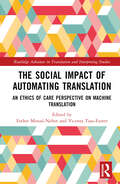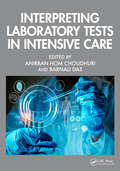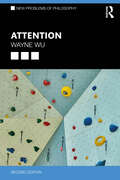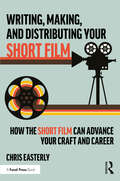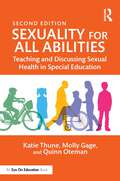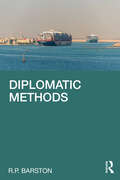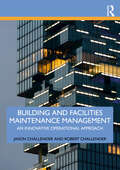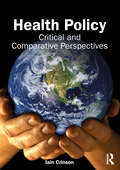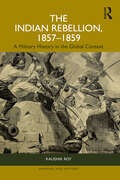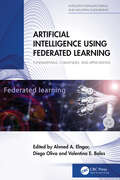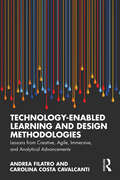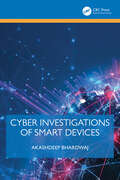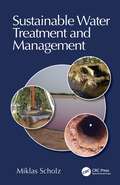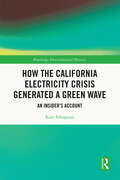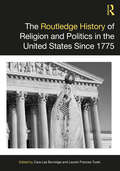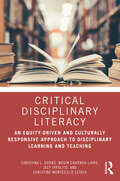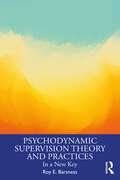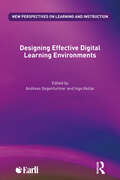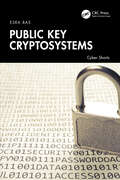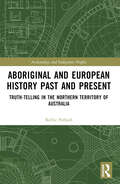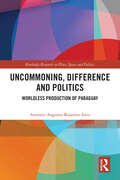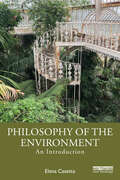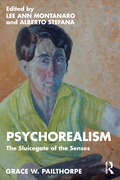- Table View
- List View
The Social Impact of Automating Translation: An Ethics of Care Perspective on Machine Translation (Routledge Advances in Translation and Interpreting Studies)
by Esther Monzó-Nebot and Vicenta Tasa-FusterThis collection critically examines the practical impacts of machine translation (MT) through the lens of an ethics of care. It addresses the ideological issues in MT development linked to social hierarchies and explores the transformative potential of care ethics for more equitable technological progress. The volume explores the ideological constructs behind MT as a labor-saving technology, how these constructs are embedded in both its development and social reception, and how they manifest in biased outputs. The chapters cover the cultural roots of translation automation, its legal and political implications, and the needs of various stakeholders. These stakeholders include lay users, Indigenous communities, institutions, educators, and professionals in an increasingly multicultural society. The book also addresses individuals who require translation daily with varying degrees of familiarity with their own translation needs and the tools available. Through critical engagement with the social impacts of MT, the book advocates for an epistemology of care to foster social equity and democratic values in technological progress. This book will interest scholars in translation studies, law, and sociotechnology, as well as practicing translators, policymakers, technologists, and activists seeking ethical and inclusive approaches to machine translation and technological development.
Interpreting Laboratory Tests in Intensive Care
by Anirban Hom Choudhuri and Barnali DasThis book incorporates a wide variety of clinical conditions requiring admission to the intensive care unit that necessitate timely performance of diagnostic tests and their correct interpretation to guide the best treatment. It tries to translate complex physiological principles and diagnostic algorithms into a clinically relevant format that can be easily understood by clinicians. It also explains at length the key clinical inputs to be acquired by laboratory physicians before reporting the results and tries to solve the common dilemmas leading to misinterpretation. The importance of every detail, from sample collection and dispatch to correlation of clinical state report, has been adequately explained with suitable examples and proper explanations.
Attention (New Problems of Philosophy)
by Wayne WuWayne Wu’s Attention was the first book to provide a systematic overview and assessment of different empirical and philosophical works on attention. In this revised and expanded second edition Wu discusses the following central topics and problems: the nature of attention and the structure of the theory of attention. explanatory integration of the psychology and neuroscience of attention. attention’s intimate relation to agency. attention and memory. the phenomenology of attention and attention as a gate on consciousness. introspective attention of consciousness. skill in attention. the epistemology and ethics of attention. attention in thought. Updated throughout, this edition includes new chapters on working memory, automaticity and skill, and attention and ethics. The breadth of coverage provides materials for advanced students and researchers in psychology, cognitive science, and philosophy. Additional features include chapter summaries, a glossary, and suggestions for further reading, making this also an ideal introduction for those new to attention.
Writing, Making, and Distributing Your Short Film: How the Short Film Can Advance Your Craft and Career
by Chris EasterlyThis book is a concise, practical guide to writing and making a successful short film. In an accessible and relatable tone, the book covers the filmmaking process from plot ideation to film distribution, without getting bogged down in the complicated details. Written by an experienced writer and filmmaker, the book shows you how to create content, from script to screen, that can connect with an audience. It does so by considering classic storytelling templates like Aristotle’s Three-Act Structure and Joseph Campbell’s “The Hero’s Journey”, as well as examining a variety of successful short films—analyzing what makes them work, or not, and why. To support learning, it also provides a list of recommended short films to study, with brief background information on each. This is supplemented with the author’s personal experiences of writing and making films, along with exclusive insights from successful Hollywood and independent writers and producers. There are also questions and prompts at the end of each chapter, uniquely designed to guide the reader through the step-by-step process of writing their own short script. Students and professionals alike who want to craft and perfect their short films will find this to be an invaluable resource and a one-stop guide to success.
Indian Economy - 2nd Edition - Competitive Exam: A complete guide on the concepts of Indian Economy for UPSC, CSE and State PCS Examinations
by Study IQ Education Pvt. Ltd.The second edition of Indian Economy by Study IQ Publications is a comprehensive guide designed to address the Indian Economy syllabus for UPSC Civil Services and State PCS examinations. Structured to cover both prelims and mains, particularly GS Paper III (Economic Development), the book provides in-depth insights into key economic concepts, policies, and trends. Topics include macroeconomic indicators, agricultural and industrial development, fiscal and monetary policies, and financial markets. Additionally, it emphasizes inclusive growth, sustainable development, and the interplay between different sectors like agriculture, industry, and services. Supported by updated data, budgetary insights, infographics, and previous years' questions, this resource aids aspirants in conceptual clarity and application. The inclusion of economic surveys and policy updates ensures that candidates are well-prepared for competitive exams.
Sexuality for All Abilities: Teaching and Discussing Sexual Health in Special Education
by Katie Thune Molly Gage Quinn OtemanThis essential manual helps educators comfortably and knowledgeably deliver lessons in comprehensive sex education to young people with developmental disabilities in the context of special education. Drawing on firsthand experience and real-world examples, the first half provides background material and tools for how to effectively partner with parents. The second half breaks down the how-tos of implementing a successful sex education program and troubleshoots tricky situations that might come up for a variety of students. Updated with new material on implementing lessons and on gender, as well as reflection questions and personal stories from self-advocates, this second edition equips you with best practices for providing students with developmental disabilities with the knowledge and tools to engage in healthy relationships and live full lives as self-advocating sexual beings.
Diplomatic Methods
by R.P. BarstonThis comprehensive volume examines developments in diplomatic technique and changes in the diplomatic and political structures which shape, and are shaped, by international relations and the international order.It provides a comprehensive foundation for understanding the theory, practice and utility of diplomacy showing how diplomatic techniques are used in different contexts and the various tools that are available to policy actors to provide a broad yet deep view of the subject area. Organised around a framework of 11 chapters, the book embraces new ideas and fresh perspectives exploring individual methods such as reorientation, replacement institutions to combat decline or ineffectiveness of existing arrangements, summit conferences, contrasting approaches to economic agreements, and use of secret diplomatic methods, among others. Furthermore, it develops new concepts such as logistics diplomacy, counter diplomacy, parallel diplomacy and the “alternative architecture”, and is widely illustrated with detailed examples including the diplomacy of geopolitics, the conflict over rules for plastics, marine resource disputes, dark trade and sanctions, and influence and strategic surprise.This textbook will be essential reading for all those interested in or studying in the fields of diplomacy, comparative foreign policy, foreign policy analysis, and more broadly, to international relations.
Building and Facilities Maintenance Management: An Innovative Operational Approach
by Jason Challender Robert ChallenderBuilding and Facilities Maintenance Management: An Innovative Operational Approach is a new introductory textbook aimed at students who are studying building maintenance and asset management for the first time as part of their undergraduate or foundation course. The book plugs a gap in the current curriculum and literature which must now seek to educate emerging professionals about the significance of the operational phase of a built asset’s lifecycle, if the challenges of the day are to be met head on.Each chapter is supported by seminar questions and formative assessment tasks to allow the learner to assess their own progress through the text and covers: The nature and importance of building maintenance for the successful strategic operation of an estate contracting and procurement of maintenance works risk assessment in maintenance management surveying for common maintenance issues and defects the relationship between maintenance management and environmental sustainability and maintenance and conservation of historic buildings The book will help readers enhance their awareness, understanding and breadth of knowledge of the issues around improving organisational maintenance management. A handy guide for emerging professionals, this practical book is also ideal reading for anyone studying facilities management, building surveying, construction management, real estate and property management.
Health Policy: Critical and Comparative Perspectives
by Iain CrinsonThis important new textbook provides comparative and critical analysis of health care policy from high-income countries in Europe to low-income developing countries in the Global South.It integrates conceptual themes drawn from the fields of sociology, policy analysis, and political science to offer a unique combination of theory, historical background, and wider social commentary. The book is divided into three sections: Section I establishes the conceptual basis for the analysis of the health policymaking process, including implementation. Section II provides an introduction to the key elements of conducting a comparative health system’s analysis, including chapters that provide examples of performance analysis in both high- and low-income developing countries. Section III examines key challenges now facing health policy-makers that include long-term social care provision, widening the scope of public health to address social inequalities in health outcome, the integration of genomic medicine within a health care system, and the establishment of an effective national pharmaceutical policy. Each chapter includes case studies, historical-institutional contexts, and summaries of key health policies. Detailed and clearly written, it is the ideal text for health and social science students in this expanding area of analysis.
The Indian Rebellion, 1857-1859: A Military History in the Global Context (Warfare and History)
by Kaushik RoyThe Indian Rebellion 1857–1859: A Military History in the Global Context focuses on the military dimension of this conflict, in which Indian rebels waged both conventional and unconventional warfare against the British.In the summer of 1857, British rule almost disintegrated in north India due to the rebellion of the Indians in the Bengal Army. The military mutiny was followed by large-scale peasant uprising. But by mid-1859, the Indian Rebellion collapsed with the military defeat of the rebels. This book is the first one based on archival sources, both from India and the United Kingdom, dealing with the military history of the mid-nineteenth century Indian Rebellion. The volume wrestles with the questions of why and how the British won, ipso facto, and why and how the rebels lost. The book also situates the military experience of the mid-nineteenth century Indian subcontinent within a global context. Besides traditional themes like strategy, tactics, technology, command, and logistics, the topics introduced by ‘new’ military history, such as experiences of war, impact on society and the construction of identities, are addressed throughout.The Indian Rebellion, 1857–1859 is essential for students and researchers of military history, modern Indian history, and British Imperial history.
Artificial Intelligence Using Federated Learning: Fundamentals, Challenges, and Applications (Intelligent Manufacturing and Industrial Engineering)
by Diego Oliva Valentina E. Balas Ahmed A. ElngarFederated machine learning is a novel approach to combining distributed machine learning, cryptography, security, and incentive mechanism design. It allows organizations to keep sensitive and private data on users or customers decentralized and secure, helping them comply with stringent data protection regulations like GDPR and CCPA.Artificial Intelligence Using Federated Learning: Fundamentals, Challenges, and Applications enables training AI models on a large number of decentralized devices or servers, making it a scalable and efficient solution. It also allows organizations to create more versatile AI models by training them on data from diverse sources or domains. This approach can unlock innovative use cases in fields like healthcare, finance, and IoT, where data privacy is paramount.The book is designed for researchers working in Intelligent Federated Learning and its related applications, as well as technology development, and is also of interest to academicians, data scientists, industrial professionals, researchers, and students.
Technology-Enabled Learning and Design Methodologies: Lessons from Creative, Agile, Immersive, and Analytical Advancements
by Andrea Filatro Carolina Costa CavalcantiTechnology-Enabled Learning and Design Methodologies offers a comprehensive and example-rich guide to the latest technological and methodological advancements in education. This book systematically organizes a rich variety of educational innovations into four distinct groups of teaching-learning methodologies, each with its own focus and disruptive potential:· Creative methodologies, centered on student protagonism and creativity, which shift the traditional roles in the teaching-learning process, empowering students to take an active, leading role in their education and encouraging creative thinking and expression.· Agile methodologies, focused on time management and adaptability, which optimize students’ time and attention through microlearning and other bite-sized content, activities, and assessments.· Immersive methodologies, driven by simulated real-world scenarios, which blur the boundaries between learning environments and real-life contexts in order to immerse learners in challenging, story-driven environments linked to clear learning objectives.· Analytical methodologies, based on computation power, which support personalized, adaptive, and evidence-based teaching and learning by collecting and processing student data.Through a practical, dialogical approach, filled with visual resources and real-world examples, the authors provide solid theoretical foundations for their methodologies of focus, positioning them within a broader spectrum that goes beyond mere consumption of isolated techniques or technologies. This will be a relevant resource for current and aspiring instructional designers, educational technologists, subject matter experts, teaching faculty, researchers, and other stakeholders involved in face-to-face, distance, or hybrid education.
The Lean Lifestyle Strategy for Businesses: An Operational Method for Entrepreneurs and Managers
by Luciano AttolicoIn a world of increasing variability and complexity, companies seem to persist in using outdated and inadequate organizational models and work patterns. Despite the available technologies and the most innovative time management techniques, we work more and more, with less results and more stress. Lean Lifestyle Strategy addresses the key problem of every professional, manager, and entrepreneur leading companies of all sizes: how to combine the need to produce more and more results, in less and less time, working better, and leading, at the same time, a lifestyle that generates prosperity and well-being. The time is ripe for lean work to become a strategy to achieve a true work–life balance and express the best of people in the company without having to choose between operational efficiency or personal fulfilment. In this book, in addition to numerous examples, tools, and step-by-step methodologies, useful to begin to apply independently the principles of the Lean Lifestyle Strategy, you will find collected the testimonies of entrepreneurs and managers who reveal the "behind-the-scenes" of successful cases in this new direction, including Campari, Cromology, ELT Group, Ferretti Group, Labomar, Lucchini RS, Marcegaglia, Orogel, Poste Italiane, Sammontana, Siemens Italia, Stanley Black & Decker, and Streparava. Through the evolution of the way we work and do business, it is possible to leave a tangible mark that starting from the company boundaries touches ourselves and the people who work with us, until positively influencing the society and the environment where we live.
Cyber Investigations of Smart Devices
by Akashdeep BhardwajThe rapid proliferation of smart devices has transformed our lives and industries, but it has also created a complex and evolving cyber threat landscape. Cyber Investigations of Smart Devices provides a comprehensive guide to navigating this challenging terrain. This book delves into the intricacies of smart device ecosystems, the fundamentals of cyber investigations, and the specific security challenges posed by IoT and smart devices.Readers will gain a deep understanding of cyber threats targeting smart devices, including their motivations and tactics. The book also offers practical guidance on implementing robust cyber defence strategies and best practices to protect critical infrastructure. It explores the complexities of cyber attribution, the forensic implications of advanced cyberattacks, and the transformative potential of emerging technologies in shaping the future of digital investigations.With a focus on AI-based cybersecurity opportunities and issues in industrial IoT, this book equips cybersecurity professionals, law enforcement agencies, and organizations with the knowledge and tools needed to effectively investigate and mitigate cyber threats in the age of smart devices. Cyber Investigations of Smart Devices is essential reading for anyone involved in cybersecurity, digital forensics, and the protection of critical infrastructure.
Sustainable Water Treatment and Management
by Miklas ScholzSustainable Water Treatment and Management covers broad water and environmental engineering aspects relevant to water resources management as well as the treatment of storm water and wastewater. It provides a descriptive overview of complex 'black box' systems and related design issues and comprehensively discusses the design, operation, maintenance, as well as water quality monitoring and modelling of traditional and novel wetland systems. Further, it provides an analysis of asset performance, the modelling of treatment processes and the performance of existing infrastructure in both developed and developing countries as well as the sustainability and economic issues involved. The book serves as a useful reference for all concerned with the built environment, including town planners, developers, engineering technicians, water and agricultural engineers and public health workers.Features: Presents the latest research findings in wastewater treatment. Includes international case studies and multi-disciplinary research projects. Explains treatment options that are applicable to any and all climatic regions.
How the California Electricity Crisis Generated a Green Wave: An Insider's Account (Routledge Environmental History)
by Kurt SchuparraThis book provides the definitive account of a decade-long transformation of energy policy in California with rippling consequences. The author, a state government “insider” during much of this period, tells a story informed by personal experience, access to the key actors of the time (both then and now), and extensive research.California’s risky experiment in deregulating the state’s electricity market in the 1990s, resulting in manipulation from unscrupulous energy providers and necessitating government action, laid the foundation for a greener grid and greater energy efficiency in the early 2000s and beyond. The book follows the state’s energy journey through Democratic Governor Gray Davis’s administration and his Republican successor Arnold Schwarzenegger’s time in office, providing a detailed behind-the-scenes account. It highlights how this period influenced broader discussions of energy policy in the U.S., culminating in President Barack Obama pledging bold action and securing $90 billion for clean energy programs in the 2009 “stimulus” bill, the largest single “green” investment in history at that point in time. The energy crisis provided a springboard for green growth by discrediting deregulation, elevating public support, and establishing a political pathway for a growing array of sustainable energy advocates.This book engagingly balances policy considerations and political drama to reveal the untold details of how the electricity crisis paved the way for key climate and clean energy policies and offers unprecedented access to archival material from the Davis administration era. It will be a must-read for energy policymakers, researchers, and environmental historians.
The Routledge History of Religion and Politics in the United States Since 1775 (Routledge Histories)
by Cara Lea Burnidge Lauren Frances TurekDrawing together history and recent historiography, this volume offers a reference work for understanding how religion influenced politics and how politics shaped religion in the United States from the American Revolution through to the present day.The book brings together some of the most well-regarded scholars in history, religious studies, American studies, political science, and other disciplines working in this field, providing a groundbreaking transdisciplinary history of this topic. It explores the major themes and historiographical trends that animate current scholarship, ensuring that readers come away with a thorough picture of the field, how it has evolved, and where future scholars might take us.This unique approach is well suited to students and scholars of both U.S. history and religious studies and encourages interdisciplinary analysis for the fields of religion and politics.
Critical Disciplinary Literacy: An Equity-Driven and Culturally Responsive Approach to Disciplinary Learning and Teaching
by Jacy Ippolito Christina L. Dobbs Megin Charner-Laird Christine Montecillo LeiderThis accessible book introduces a new theory of critical disciplinary literacy (CDL) that merges criticality and disciplinary literacy approaches in a cohesive and inclusive framework. There are unique hurdles in integrating critical and culturally sustaining approaches to literacy into specialized content area classrooms, but this book provides clear, research-grounded strategies and methods that will appeal to teachers and help them foster equitable literacy learning opportunities for all students. Using a critical lens, chapters deconstruct and reconstruct pathways for new practices that push back on familiar, normative literacy approaches in the disciplines. Authors provide a framework for designing new approaches to disciplinary literacy both for and with students, and they present innovative and practical strategies for implementation. With real-world examples from the field, this book will be essential reading for preservice teachers and in courses on literacy and disciplinary instruction.With vignettes and classroom examples from educators who have been enacting elements of CDL practices for years, this book will be essential reading for preservice educators in courses on both literacy and content instruction. Furthermore, current and seasoned educators and educational leaders will find this book to be an invaluable resource as they wrestle with how to teach disciplinary literacy in ways that move away from approaches that have historically marginalized many voices to approaches that include and center students’ languages, histories, and cultures.
Psychodynamic Supervision Theory and Practices: In a New Key
by Roy E. BarsnessThis book sets out a new model for psychodynamic supervision, designed around relational psychoanalytic theory and practice. It emphasizes the development of the self of the therapist and working directly with the emergent therapeutic relationship. Building on Barsness’s seminal Core Competencies of Relational Psychoanalysis text, this book is grounded in those theoretical competencies. The author offers what he calls the MAMAL method of supervision—(M—muse; A—affect; M—metabolization; A—articulation; and L—learning), a method that privileges (1) affect over cognition, (2) the use of the therapist’s subjectivity as the primary portal to the patient’s internal and interpersonal world, (3) the immersion of the supervisor’s subjectivity in the supervisory process, and (4) viewing the patient as a muse rather than an object of assessment. The MAMAL method approach enriches the supervisory experience and enhances the therapeutic process, fostering a therapeutic climate where both therapist and patient can thrive. It is attention to our own humanity and woundedness that facilitates a deep connection to our patients and animates the progression of the therapeutic process and is at the core of this supervision model.Drawing on clinical experience, this book is grounded in research and is a readable resource for psychoanalysts, psychotherapists, and mental health professionals, providing a clear guide to a relational model of supervision and a concise understanding of relational theory and practice.
Designing Effective Digital Learning Environments (New Perspectives on Learning and Instruction)
by Andreas Gegenfurtner Ingo KollarBringing together the research of leading international scholars in the field of digital learning, Designing Effective Digital Learning Environments discusses cutting-edge advancements in digital technology and presents an evidence-informed summary of best practices for effective design principles and implementation within educational settings.Readers will benefit from a synthesis of research evidence from previous meta-analyses on how to design digital environments that support learning, motivation, and collaboration. Divided into eight thematic parts, chapters unpack: An introduction to the design of digital learning environments Learning with multimedia, with particular emphasis on digital reading comprehension environments and GeoGebra software Digital videos for learning, including dynamic visualizations, instructional videos, and eye movement modeling examples Simulated realities, including learning with pedagogical agents and immersive virtual reality environments Game-based and sensor-based learning in digital environments Digital learning in social contexts, including a discussion of CSCL, social media, and audience response systems Design of digital classrooms, including flipped classroom approaches and synchronous online learning A concluding section discussing the efficacy and design of digital learning environments This edited volume is an essential read for any scholar, researcher, Ph.D., or Masters student working in the field of digital learning.
Public Key Cryptosystems (Cyber Shorts)
by Esra BasThis book is a short book about public key cryptosystems, digital signature algorithms, and their basic cryptanalysis which are provided at a basic level so that it can be easy to understand for the undergraduate engineering students who can be defined as the core audience. To provide the necessary background, Chapters 1 and 2 are devoted to the selected fundamental concepts in cryptography mathematics and selected fundamental concepts in cryptography.Chapter 3 is devoted to discrete logarithm problem (DLP), DLP-related public key cryptosystems, digital signature algorithms, and their cryptanalysis. In this chapter, the elliptic curve counterparts of the algorithms and the basic algorithms for the solution of DLP are also given. In Chapter 4, RSA public key cryptosystem, RSA digital signature algorithm, the basic cryptanalysis approaches, and the integer factorization methods are provided. Chapter 5 is devoted to GGH and NTRU public key cryptosystems, GGH and NTRU digital signature algorithms, and the basic cryptanalysis approaches, whereas Chapter 6 covers other topics including knapsack cryptosystems, identity-based public key cryptosystems, identity-based digital signature algorithms, Goldwasser-Micali probabilistic public key cryptosystem, and their cryptanalysis.The book’s distinctive features: The book provides some fundamental mathematical and conceptual preliminaries required to understand the core parts of the book. The book comprises the selected public key cryptosystems, digital signature algorithms, and the basic cryptanalysis approaches for these cryptosystems and algorithms. The cryptographic algorithms and most of the solutions of the examples are provided in a structured table format to support easy learning. The concepts and algorithms are illustrated with examples, some of which are revisited multiple times to present alternative approaches. The details of the topics covered in the book are intentionally not presented; however, several references are provided at the end of each chapter so that the reader can read those references for more details.
Aboriginal and European History Past and Present: Truth-telling in the Northern Territory of Australia (Archaeology and Indigenous Peoples)
by Kellie PollardThis book analyses the 150-year history of continuous contact between Aboriginal people and non-Aboriginal people in the Darwin region of the Northern Territory of Australia after the European invasion in 1869 to the present day.It explores the role Aboriginal fringe camps served, and still do, as places of interface between Aboriginal people and non-Aboriginal people in the context of ongoing colonialism after colonisation. The book argues that Aboriginal fringe camps provide much potential for elucidating aspects of Aboriginal responses to the European invasion and, in a contemporary context, bear distinct evidence of a cultural nature that associates their origins, use, purpose, and functions predominantly with Aboriginal people. It contributes a new and innovative theoretical model that will enable readers to conceive how insights about Aboriginal behaviour in the context of Aboriginal fringe camps were achieved. The model is informed by the frameworks of colonialism and, innovatively, philosophy.Contributing new theoretical knowledge to contact histories and relations between Europeans and Indigenous peoples, the book will be important to researchers in the archaeology of Australia and those concerned with Indigenous Studies.
Uncommoning, Difference and Politics: Worldless Production of Paraguay (Routledge Research in Place, Space and Politics)
by Antonio Augusto Rossotto IorisThe book presents a reinterpretation of the meaning and practices of uncommoning. It provides a critical reflection on the frontiers of the modern world where uncommoning is often the key driving- force underpinning a deceitful democracy and an exclusionary socio-economy. Uncommoning is a socio-spatial process of othering, grabbing and reordering that particularly impacts indigenous peoples.This book revisits classical, contemporary and decolonial literature, as well as documents, reports and archival data, to analyse the Paraguayan case of uncommoning. It examines how these processes have deep roots in the shortcomings of Western thinking, including religious, juridical and moral doctrines. The book also demonstrates that Europe has major responsibilities and cannot be removed from the search for responses and alternatives. After a detailed theoretical elaboration, informed primary by Hegel’s socio-spatial sensibilities, the book empirically analyses the ‘worldless’ production of Paraguay as a country with a fragile sovereignty and whose development is, more than anything else, highly subtractive.The text will be of interest to scholars and researchers in development, indigenous studies, decolonisation, human geography, agribusiness, South American studies, as well as policy-makers in international development agencies and NGOs.
Philosophy of the Environment: An Introduction
by Elena CasettaThis textbook offers a reasoned and accessible introduction to the philosophy of the environment and the current environmental crisis, designed for scholars and students in both philosophy and the natural and environmental sciences.The volume addresses the history and meanings of the concept of "environment", provides a theory of the relation between living beings and their environments, and tackles a wide spectrum of key philosophical issues related to the environment and the environmental crisis in a straightforward framework and accessible style. The book’s unique approach to environmental philosophy addresses the environment of all living beings and extends beyond environmental ethics to include conceptual history and analysis together with insights from evolutionary and developmental biology, ecology, and environmental and conservation sciences. The book consists of five chapters, each built around a specific thesis drawing upon philosophers and concepts including George Canguilhem, Rachel Carson, Donna Haraway, Lamarck’s and Darwin's evolutionary theories, Humboldt’s theory of nature, and the Gaia hypothesis. The final chapter introduces topics such as environmental denialism and post-natural environmentalism as conceptual tools for better understanding the current ecological crisis.Targeted at students and scholars in both philosophy and the environmental and life sciences, the book distinguishes itself through its approachable style and choice of topics, which are also well suited to junior researchers who seek to better understand the current environmental crisis.
Psychorealism: The Sluicegate of the Senses
by Grace W. PailthorpeThis book brings Grace Pailthorpe’s previously unpublished work to readers for the very first time and explores the profound impact of early childhood development on one’s psychological well-being. Through her innovative concept of psychorealism, Pailthorpe offers a unique blend of art and psychoanalysis aimed at understanding and balancing the human psyche.The book delves into the mechanisms by which infants develop fundamental psychological patterns. Pailthorpe argues that understanding these early developmental stages is crucial for addressing psychological imbalances. Psychorealism, as she defines it, involves creating art free from conscious interference, allowing for the pure expression of psychic realities. This form of automatic creativity offers fresh insights into the symbolic essence of the psyche and its influence on human behaviour. By analysing psychorealistic art, Pailthorpe illuminates the complex facets of human behaviour and provides a novel perspective on the interplay between the unconscious mind and artistic expression. Pailthorpe’s research stands out for its originality and practical application. Her work not only enriches the field of psychoanalysis but also provides valuable tools for therapeutic practices.This book is particularly useful for psychologists, art therapists, and scholars interested in the intersections of art and psychology, offering new methods for understanding and treating psychological issues through creative expression. This approach will also appeal to general readers, librarians, and booksellers with its intriguing integration of art and psychology.
